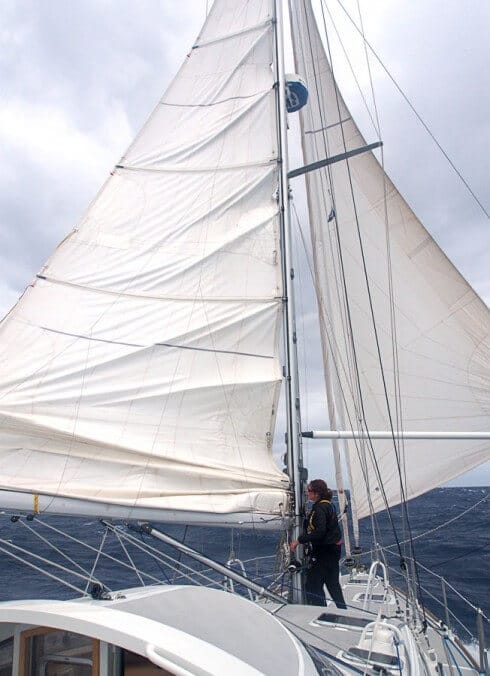
Cruising books, wise sailors, and this website all promote the benefits of simple boats and systems. Our journey from vacationing on a smaller and simpler boat (35′ Cape George Cutter), to sailing full time for two and one-half years on a more complex one (Boreal 47′), has taught me that simplicity is a journey, not a destination.
Why Simple?
Why the zeal for simplicity?
- In tough conditions simple gear is more reliable.
- Waiting for parts and repairing complex systems is a sunk cost against living one’s dreams.
- Simple usually equates to equipment I can fix as a non-professional, with basic tools, some spares, the manual, a little common sense, and a lot of patience.
Where to Stop
On the other hand, voluntarily assumed complexity for a desired benefit is an individual’s perogative. I am not a Luddite. Sailing for five days with a seized engine through the Bahamas was enough engineless sailing experience for me. Moreover, I do not want to give up our electronic charts, windlass, or sat-phone.
The Best Systems
The best equipment is both easy to use and fault tolerant, such that failure is not catastrophic; for example, slab reefing that “fails” to less, not more, sail area.
Elegant systems include redundancy—like dual iPads for plotters—or alternatively allow for repairs at sea; for example, using a topping lift as a spare halyard.
But duplication is not always the best redundancy: rather than have a spare auto-pilot, we have an auto-pilot and wind self-steering gear. Combined they are a more robust and higher performance solution.
For some unrepairable gear, such as GPS, we carry duplicates, but we must stop somewhere. Redundancy is good until it becomes too costly, too complex, or until the layers of redundancy overfill the lazarette.
Modern Is Not Always Better
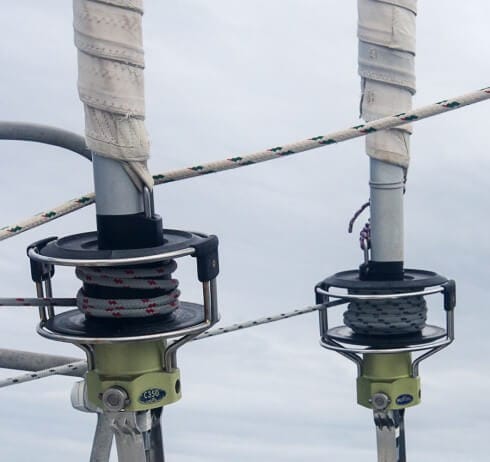
Traditional systems are often the most reliable because they are the product of years of distilled experience and wisdom, such as go-to-the-mast slab reefing. Some “modern” gear, like headsail furlers and self-tailing winches, have come of age and are worthy improvements.
Storm Sails…or Not
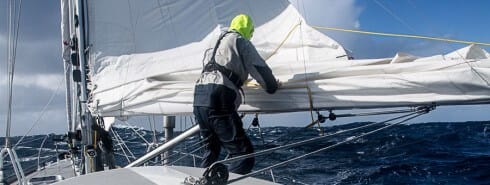
Yet sometimes new perspectives are simpler: we have no storm jib and no tri-sail aboard and believe it to be the right solution for us, on our boat, at this time.
Building off the ideas of the charter boats that ply the Chilean Channels, South Georgia, and the Antarctic, we had three reefs for the main and then added a fourth stormsail-sized reef. The fourth reef was made possible by large reefing hooks, correctly sized earrings (reefing rings), and switching the outhaul to a lashing to free up a boom end sheave for the fourth reefing line. The reef lines, lazy-jacks, and stiff sail cloth control the bunt without any reefing ties. While it is not pretty, this system is functional and chafe-free.
We know our storm sails are functional because we use them daily and can set them alone in the time it takes us to put in a reef. The third or fourth reef plus the staysail (a stoutly built self-tacking sail on a ProFurl furler) has also proven itself to be a great way to slowly and calmly make way or to heave-to in high winds, and leaves little sail to furl when dropping the main completely. Overall, this is the sort of functional simplicity we like.
Some folks will see our approach as imprudent, quoting the “what-ifs” of a broken boom, shredded mainsail, parted halyard, all with a looming lee shore, but we have fortified our aluminum boat with a basic diesel engine, pre-rigged Jordan Series Drogue, spare halyards, good tools, comprehensive spares, and a belief that after the third “what-if” the best response is ingenuity and tenacity, not more equipment.
When Modern Pays
Technology worth adopting should be higher performance, simpler to use, and more reliable–such as replacing cleats with rope clutches on frequently-used lines.
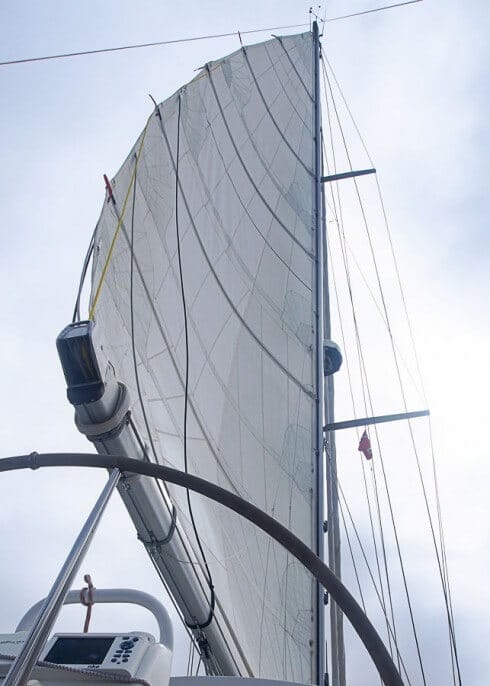
Our mainsail with poly-hydrant sailcloth, full-length battens, and Antal low-friction batten car system, appears to meet this test. After two years and 28,000 nm we can still easily tuck in reefs off the wind, the mainsail has good shape, and is ready for another couple of years.
In contrast, we found our Gyb’Easy boom brake to be less functional than traditional preventers on a boat our size.
In the un-needed tech category, we have a basic EchoPilot forward-looking sonar unit that we could do without; it is functional but not much better than our “dual forward scanning sonar,” which is two kids on the foredeck.
Simple, Not Always Cheap
Unfortunately, simpler is not always cheaper. Our skinny and strong high-modulus 200-meter shoreline is a joy to row ashore in a windy anchorage but not to buy.
Our sails were about double the cost of Dacron and we will be lucky if they are actually cheaper per mile sailed but, in the meantime, we get good sail shape—a worthwhile trade off for us, but it is not obviously better than good old Dacron.
Our racing pedigree NKE autopilot and Lecomble & Schmitt ram steer brilliantly and are relatively low draw, but were pricey.
However, sometimes simpler is cheaper. Six hundred liters of water capacity gives us a month’s supply. Washing dishes in salt water, sponge baths in lieu of showers, and a water collection tarp, allowed us to go more than three months in the rainy Chilean Channels without having to refill from a hose.
For us, this is simpler and cheaper than a water-maker and, anyway, even if we had one we would not sail offshore depending on it for survival, so we want to have trans-ocean capacity aboard. However, if we were headed to the lonely atolls of the Pacific, we might well install a water-maker.
Choose Simple
As a general rule, more parts and steps in a given system increase the likelihood of failure. Hence an excellent single-line reefing system lead back to the cockpit is attainable but it will not be intrinsically more reliable than slab reefing at the mast—for the most important systems, such as sail handling and life safety, we strive for functional simplicity.
Complex Does Not Make Safe
It is easy to be in awe of technology and blind to the real costs, risks, and benefits. Oftentimes, I find gear such as a combined auto-inflating life-vest and harness to be a source of complexity and false confidence, not necessarily a “safer” alternative—safety Of Life At Sea is not an intrinsic outcome of complex safety equipment; good seamanship is the dominant variable.
Skills Better Than Gear
We have found that investing time and resources to acquire knowledge and skills pays higher dividends than buying equipment. For our family, self-study combined with a marine weather course is one of the best investments we have made toward managing the risks of offshore sailing. A marine diesel engine course more than paid for itself in foregone paid professional services and gave us the confidence to explore remote places.
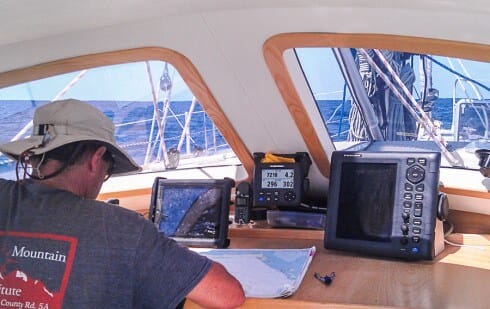
Much of the sailing industry thrives on selling equipment as solutions to real and perceived problems, frequently making the industry an enemy of simplicity. For us, technology such as radar images overlaying on electronic charts is a cool solution in search of a substantive problem. We are very happy with our Furuno radar screen and iNavX plotter on an adjacent iPad. Likewise, spending more resources on buying your medical and drug kit than on learning medical skills seems silly.
We Ain’t That Simple
We left off some common equipment and systems without regrets, but still have plenty of complexity aboard. Some of our additions were clearly worth it for us, such as our Refleks diesel heater.
A few boat options were retained on the dubious basis of future resale. If we were starting over, we would probably forgo the pressurized hot and cold water, consider composting heads (although our Lavac heads are excellent), and change our shore power arrangement. Because we use our isolation transformer and AC power plugs so little (only works on shore power), a simpler setup would suffice.
Sometimes I wish we had an SSB for weather faxes, and a NavTex receiver, but the sat-phone email is good enough. We do have a Furuno Class B AIS transceiver, and Furuno 1835 radar with ARPA, and appreciate both, although the icebergs never got the memo about broadcasting an AIS signal.
Simple Electrical
Reading John’s excellent online book on batteries and charging systems was part of the inspiration for our electrical system. By forgoing refrigeration, water-maker, inverted AC power, and using low-draw equipment where possible, we combined low demand with high battery capacity and diverse charging sources (alternator, solar panels, and wind generator).
This resulted in a system that treads lightly on our gel batteries (rarely cycle below 85% and recharge to 100% every day or two at most), so we don’t need a generator, nor do we run the engine solely to charge the batteries, and rarely bother with shore power in the marina.
The Price of Simplicity
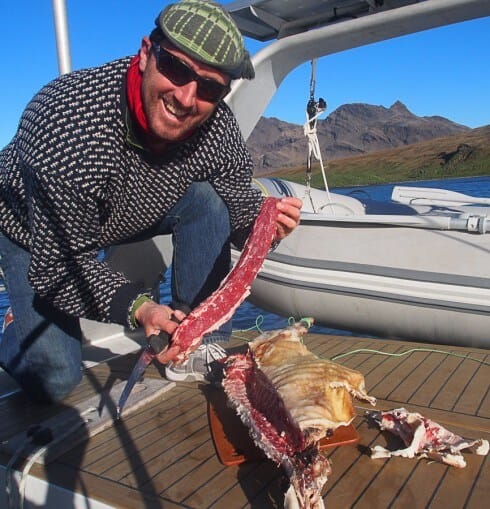
The price for simplicity on a boat is learning to live without and to tolerate some inconvenience:
- Life without refrigeration is different but only a nominal compromise once above 40 degrees latitude.
- Going to the mast to reef can be wet, which inspires us to dress for the weather on watch–not such a bad thing.
- A three-litre sponge bath is not as satisfying as a 20-litre shower, but it is not a true hardship.
- For us, minding the amps of consumption is a cheap price for never having to listen to or maintain a generator.
Conclusion

Simplicity is in the eye of the beholder. The “best” way is elusive and unique to each sailor, boat, and cruising area. Skipping a few of the common or fancy systems can pay large dividends in creating overall functionality, establishing ease of maintenance, and in allocating resources toward one’s sailing goals. Less really can be more.
I do envy other sailors their cold drinks on a hot day, but for us a somewhat simplified boat made it easier for us to get to and then explore places like South Georgia–a worthwhile trade. Undoubtedly there are many simpler solutions I have yet to deduce; I look forward to discovering them as we sail onward.
Editor’s Note
Longtime readers of this site will note that the Barnes family have made some very different choices than those made by Phyllis and I, or Colin and Louise, most notably in the area of dedicated storm sails.
On the other hand, they have validated these different choices with a 30,000 mile circumnavigation of South America with a stop at South Georgia, one of the world’s most challenging cruising destinations.
We published this really interesting article, complete with said differences, in keeping with our fundamental belief that there are a lot of right ways to get out there, rather than just our way, and that well-informed and experience-based diversity of opinion is always useful.
To help you, our readers, look at the options and figure out your own way, we have added the links below to chapters detailing our approach:

Hi Chris
Great summation of the secrets to successful voyaging under sail!
I particularly liked the philosophy of functional necessity as a counterpoint to a “sailing industry (that) thrives on selling equipment as solutions to real and perceived problems, frequently making the industry an enemy of simplicity.”
ps. As a former Cape George owner/builder, if I should have the good fortune to be reincarnated as a human rather than a cockroach I’ll be a Boreal owner in the next life!
Some years ago, descending from a significant ice climbing route with my long-time partner, after a long and challenging, but wonderfully uneventful day (no accidents), conversation wandered to how, in all of these years, we had never shared an “epic.” At length, the answer was that the difference between and “epic” and dead was often quite thin. Moreover, we had been climbing together for over 20 years, and it was only that day that we finally had the skill set to safely take on a major route without getting in over our heads. It was skill rather than complex equipment that had made for smooth, steady progress up difficult rock and ice.
But really, we had read of all the required skills in book 20 years earlier. It just took 20 years of practice for enough of the subtlety and significance to sink in. And old as I am, my ability on vertical ice is still improving, certainly not as a result of new strength, but from making very few mistakes.
We can buy (the illusion of) safety, but I’ve never learned how to acquire deep experience quickly. It’s darn frustrating, but it keeps us coming back.
Hi Drew
there’s a strong synergy between safe climbers (= alive) and safe sailors in my experience. Two of the best first mates I had in my working days were both highly capable climbers, and the time it took them to become excellent sailors was drastically shortened by their climbing experience. But that didn’t mask the fact that it had taken them years to attain those skills – just as it does in sailing.
Great article!
Colin
Drew – thanks for your comment. I repeatedly find that my time in the mountains, especially backcountry skiing in the Colorado snowpack, challenged and inproved both my risk management and decision making skills. While certainly not all directly applicable to sailing, the mindset of evaluating the likelihood and consequence of potential risks has proved invaluable. The mantra of “skill over equipment” is also particularly relevant. – Christopher
Hi Drew, Colin and Christopher,
I too have noticed that climbers just get how to apply the mix of experience and training to making any sport safer. We had a ski mountaineer as crew for two of our fairly aggressive Arctic trips, and, despite the fact he knew absolutely nothing about offshore sailing, he still taught Phyllis and I huge amount about managing risk intelligently.
It’s also interesting to note that it was climber/sailors (like Drew) that first recognized that the common assumption in the sailing world about POB prevention systems were rubbish.
I wonder if the reason that climbers tend to be so much better than sailors at this is simply because their sport is fundamentally far more dangerous than ours—it’s a lot harder to remain deluded about poor procedures, training, and gear, if said delusions kill a few of your colleagues.
Hi John,
Strongly agree! A Brazilian colleague (who collected high altitude climbs like some people collect marathons) explained to me that to a climber the summit is the wrong objective. Most climbers actually die on the way down – when they are looking forward to getting to base, probably oxygen deprived, perhaps dehydrated, certainly tired. They have to assess the risk of the whole climb and then plan to not make mistakes, doubly so when the end is in sight. I have often wondered since then, what is our equivalent of “on the way down”? When do we as a group drop our guard?
I also think Darwin comes into play here – we have probably all met some old bold sailors but there are no old bold climbers!
Thanks Chris for sharing some of your critical thinking and experiences.
Rob
Simplify, simplify, simplify. Excellent article !!! Thanks!
Hi Chris,
Thanks for a great article. We have a similar philosophy on our boat, a Garcia 45, but I have picked up a number of ideas from your article like using the outhaul sheave to rig the 4th reef. I have a few questions if you do not mind me asking:
– is your 4 th reef always rigged… It is a pretty long line up and down the sail when not in use…
– is your 200 meter high modulus line in 8 or 10 mm. I need to make this investment , and our boat has a similar displacing to yours.
– have you ever deployed the Jordan drogue?
Many thanks
Chris
Chris,
Thanks for your comments. Yes we have the fourth reef always rigged and the reef line is long, a couple of big looped zip ties on each side to the third reef eye keep it tidy and break when reefed on. Our shorelines are 3/8″ (9mm) and has worked well when we need it. We have not used the Jordan Series Drogue so my knowledg is theoretical only for the Drogue. – Christopher
Super article! Thanks!
What is a “skinny and strong high-modulus 200-meter shoreline”? Is this a dinghy or a typo?
How about an article on dinghys? We have a hard bottom rib but it does not stow anywhere except on davits. This is not particularly desirable at sea and limits installation of a windvane. Suggestions would be appreciated.
Hi Charles,
Chris is referring to a shorefasts made of Spectra.
As to dinghies:
Here is our thinking on clear decks: https://www.morganscloud.com/2011/02/25/clear-the-decks-for-action/
And our dinghy:https://www.morganscloud.com/2010/11/12/avon-dinghy-take-two/
Charles – we have a 10ft Zodiac with a high pressure floor so that we can roll it up and keep it off the deck entirely when offshore. Works fine, rows terribly, and is a good all round comprimise…
great article. well thought out. or better said: well experienced.
one question that was not asked above: what is “polyhydrant sailcloth”? I tried to look it up but did not find it.
Clifford
Hi Clifford
Polyhydrant cloth is perhaps better know by its trade name of Hydranet, and is Dacron reinforced with woven Dyneema. It’s tough and durable and holds its shape far better than straight Dacron.
Best wishes
Colin
Clifford – Colin has it exactly right, I can’t keep all the type verses brand names straight… My apologies. Christopher
To be even more specific, it is Radial Hydranet from Dimension Polyant, woven and finished in Germany. Colin is right about tough and durable. However, there is a cross-cut version available as well, which I don’t have any direct experience with, but in my line of work I have spoken with many sailmakers around the world about different cloths, and it seems no one likes the cross-cut version very much. So if you can afford to make sails from Hydranet, I would highly recommend biting the bullet and going for Tri-radial or Bi-radial construction and use the Radial version of Hydranet. Your wallet will hate you, but you will thank yourself years down the road while sailing.
Christopher is also right about regular high-quality polyester sails, which would be less than half the cost. Not all dacron is created equally, though, so do your research!
Hi Nate
re cross cut Hydranet, I know a little of the history of this as when we had our sails made (late 2007) we had our main and staysail made in cross cut Hydranet – the Yankee is radial.
At the time there was considerable comment that there was a problem with radial Hydranet, and some sailmakers didn’t like it. However, in later years some other sailmakers claimed that the problem didn’t lie with radial Hydranet but a lack of understanding of how to use it.
We opted for cross cut main and staysail for their stability in light of the above information. However, when we replace them it will be definitely be for sails made from radial Hydranet.
Not that the cross cut sails have let us down – far from it. After c. 25K miles they both still hold their shape and have plenty of life in them.
Best wishes
Colin
Thanks, Colin. Good to hear from someone with positive experience regarding fill-oriented Hydranet, even if you will switch to warp-oriented in the future.
Best,
Nate
Hi Christopher,
Excellent article. As I’m sure you’ve considered this, what additional power sources would you have needed to add to your boat’s grid to be able to accommodate refrigeration? That might be the thing I’d miss the most. Many thanks.
a Boreal kept simple, this is just a double dream indeed, the best of all worlds, the KISS principle at its best,
quite essential as my long career at sea, and the Romanée and her designer Harlé teached me, simple and strong is just a basic,
another article of Beth and Evans highlighted that too, “simple but sphisticated” :
http://www.bethandevans.com/pdf/SimpleBoatsystem.pdf
Hi everyone,
Another vote for Hydranet radial. We have 2 seasons, around 6-7000 miles on our mainsail, staysail and jib topsail and we just went over them with our sailmaker. (This was mostly coastal cruising which, in many respects, I consider harder on sails than mileage gained offshore.) We both agreed they looked new.
I would also underline the safety aspects of the slippery mainsail track, ours is also Antal.
My best, Dick Stevenson, s/v Alchemy
I thought it might be interesting to look at a totally different simpler modern boat. Sierra Cloud is now 27 years old, having spent every winter hauled out and buried in the Lake Tahoe snow and every summer carrying passengers on the lake. She has survived full speed impacts by jet skis and all the abuse that hundreds of thousands of paying customers can dish out.
Construction: three layers of doorskin plywood plus spruce stringers all encased in epoxy. 55′ long x 28′ beam. Unsinkable.
Haul out photo here: http://multihullblog.com/
And check out the photo of a 65′ power catamaran afloat after being stolen and run onto a reef at speed. http://multihullblog.com/